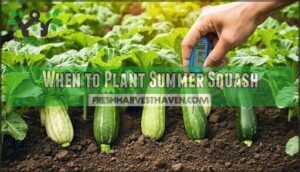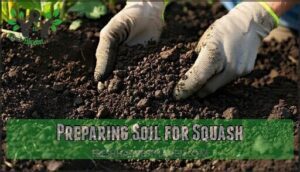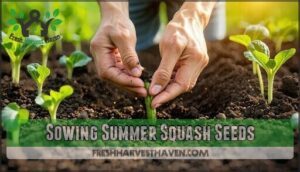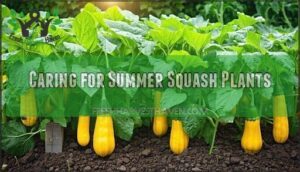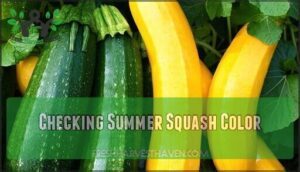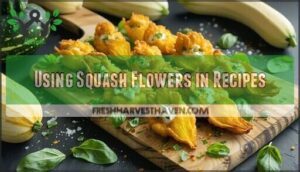This site is supported by our readers. We may earn a commission, at no cost to you, if you purchase through links.
 Easy harvesting of summer squash becomes second nature once you know the timing. You’ll want to pick your squash when they’re young and tender, typically 6-8 inches long for zucchini and when yellow varieties show bright color.
Easy harvesting of summer squash becomes second nature once you know the timing. You’ll want to pick your squash when they’re young and tender, typically 6-8 inches long for zucchini and when yellow varieties show bright color.
Check your plants daily since squash grows faster than weeds in July heat. Use a sharp knife or pruning shears to cut the stem cleanly, leaving about an inch attached.
Don’t twist or pull the fruit, as this can damage the plant. Harvest in the morning when it’s cooler and the squash feels firm to the touch.
The secret lies in understanding exactly when each variety reaches peak flavor and texture, which is crucial for the best harvest.
Table Of Contents
- Key Takeaways
- Choosing Summer Squash Varieties
- When to Plant Summer Squash
- Preparing Soil for Squash
- Sowing Summer Squash Seeds
- Caring for Summer Squash Plants
- Identifying Ready to Harvest Squash
- Harvesting Summer Squash Flowers
- Storing Harvested Summer Squash
- Frequently Asked Questions (FAQs)
- How to tell when summer squash is ready to pick?
- What do squash plants look like when ready to harvest?
- How many squash will one plant yield?
- How big should I let my squash get before I pick it?
- How to avoid overripe summer squash during harvest?
- What tools are best for harvesting squash?
- When is the best time of day to harvest?
- How to handle squash plants without damaging them?
- Can overgrown squash still be used effectively?
- What tools are best for harvesting summer squash?
- Conclusion
Key Takeaways
- Harvest at the right size for best flavor – Pick zucchini when they’re 6-8 inches long and yellow varieties at 4-6 inches, checking plants daily since squash grows rapidly in summer heat.
- Use proper cutting technique to protect plants – Cut stems cleanly with a sharp knife or pruning shears, leaving about an inch attached, rather than twisting or pulling, which damages the vine.
- Time your harvest for optimal quality – Pick in the morning when it’s cooler and the squash feels firm, looking for glossy skin that yields slightly to gentle pressure.
- Don’t let squash get oversized – Check plants every other day during peak season, since squash can double in size overnight, becoming tough and seedy if left too long.
Choosing Summer Squash Varieties
You’ll find three main types of summer squash that offer different shapes, sizes, and harvest requirements for your garden.
Zucchini produces long cylindrical fruits, crookneck varieties develop curved necks with bumpy skin, and patty pan squash grows in round, scalloped shapes that resemble small flying saucers, including zucchini.
Popular Summer Squash Types
Summer squash varieties offer gardeners exciting choices for their harvest.
Here are five popular types that’ll transform your garden experience:
- Zucchini varieties – Classic green cylinders perfect for bread and stir-fries
- Yellow squash and straightneck types – Bright, buttery flavors
- Patty pan with distinctive scallop squash edges – Adorable UFO shapes
- Crookneck uses – Curved necks add visual interest
- Unique hybrids – Modern pattypan shapes combining best traits
Zucchini and Crookneck Squash
Zucchini and crookneck squash offer distinct advantages for your summer squash harvest.
Zucchini ripeness shows through glossy, dark green skin and tender texture, perfect for unique recipes from bread to stir-fries.
Crookneck shapes feature curved necks with bumpy, yellow skin that signals peak flavor.
Taste differences emerge clearly – zucchini delivers mild, versatile flavor while crookneck provides slightly sweeter notes.
Growing challenges include managing rapid growth, but easy squash picking rewards come when harvesting zucchini at 6-8 inches for ideal tenderness, which is a key factor in achieving perfect tenderness.
Round and Scalloped Squash
Patty Pan Types and scalloped varieties offer unique shapes that’ll make your garden stand out.
These summer squash gems have a mild Scallop Squash Flavor perfect for stuffing and grilling. You’ll want to harvest them at 3-4 inches diameter for the best texture.
Don’t forget about Harvesting Blossoms – they’re edible too! Preventing Bruising means gentle handling during your summer squash harvest.
For a comforting side dish, consider making a squash and tomato gratin.
When to Plant Summer Squash
Timing your planting right makes all the difference between a thriving garden and disappointed hopes. You’ll want to wait until soil warmth reaches at least 60°F before sowing seeds. Cold soil stunts growth and can kill tender seedlings before they establish.
Wait for 60°F soil warmth before planting – cold ground kills tender seedlings before they can establish.
Check your local frost dates carefully—summer squash won’t tolerate even light frost. Most hardiness zones allow safe planting time from late May through early June, but southern gardeners can start earlier.
Soil temperature matters more than air temperature for successful germination. Use a soil thermometer to verify conditions rather than guessing. Your varieties will thank you for this patience.
Consider seed starting indoors 2-3 weeks before your last frost date if you’re keen to get ahead. This gives you transplant-ready seedlings when outdoor conditions improve.
Stagger plantings every two weeks through mid-summer for continuous harvests. This soil preparation timing strategy keeps fresh squash coming until fall frost arrives. To further maximize your harvest, consider succession planting benefits by staggering crops in intervals.
Preparing Soil for Squash
You’ll need warm soil that reaches at least 60°F before planting your summer squash seeds for ideal germination.
Choose a sunny location with well-drained soil enriched with compost to give your plants the nutrients they need for productive growth.
Soil Temperature Requirements
Checking soil temperature with soil thermometers before planting guarantees your summer squash seeds have the best chance to thrive. Wait until your soil reaches at least 60°F, but ideally 65°F to 75°F for ideal germination rates and seedling growth.
Consider these essential temperature strategies:
- Use black plastic mulch to accelerate soil warming and retain heat
- Install cold frames to protect seedlings from unexpected temperature drops
- Water soil before chilly nights to store heat naturally
- Monitor daily temperatures for consistent germination success
Proper soil temperature timing makes sowing seeds dramatically more successful.
Full Sun and Soil Conditions
Since summer squash thrives in warm conditions, you’ll need full sunlight for at least six hours daily.
Well-draining soil with proper soil pH between 6.0-6.8 guarantees healthy root development.
Test your soil nutrients and add compost to improve drainage.
Apply mulch around plants to retain moisture and regulate soil temperature.
Proper soil conditions equal abundant harvests!
Sowing Summer Squash Seeds
You’ll plant summer squash seeds directly in your garden once soil temperatures reach at least 60°F and all frost danger has passed.
Place seeds about one inch deep in well-drained, compost-enriched soil with full sun exposure to promote strong germination and healthy plant development.
Direct Sowing Into Garden Soil
Once your soil temperature reaches 60°F, you’re ready for direct sowing summer squash seeds.
Proper soil preparation creates the foundation for excellent germination rates and healthy plants.
Here’s your direct sowing checklist:
- Seed spacing: Plant seeds 3-4 feet apart in rows
- Soil amendments: Mix compost into planting areas beforehand
- Pest protection: Consider row covers for young seedlings
- Watering schedule: Keep soil consistently moist but not waterlogged
Optimal soil conditions guarantee strong plant establishment.
Sowing Seeds at Correct Depth
Getting your seed depth right is like finding the sweet spot on a guitar – one inch deep hits the perfect note for summer squash success.
Seed Depth Importance directly affects your Germination Rate Factors and Seedling Vigor. Here’s your planting playbook:
- Plant seeds exactly 1 inch deep in well-prepared soil
- Adjust depth based on Soil Type Impact – lighter soils need slightly deeper placement
- Space seeds 2-3 feet apart for ideal squash plant care
- Apply Depth Adjustment Tips by checking soil moisture levels first
These squash growing tips guarantee robust summer vegetables ready for harvesting.
Caring for Summer Squash Plants
Once you’ve planted your summer squash seeds, proper care guarantees healthy plants that’ll produce abundant harvests throughout the growing season.
You’ll need to maintain consistent watering, apply mulch for moisture retention, and provide adequate support as your plants grow larger, which is crucial for healthy plants.
Watering and Mulching Requirements
How often should you water your summer squash? Deep watering once weekly works best, delivering at least an inch of water to maintain consistent soil moisture.
During hot spells, you’ll need to increase watering frequency to prevent stress.
Water your summer squash deeply once a week, ensuring steady soil moisture for vibrant, healthy plants.
Apply mulch types like grass clippings, straw, or shredded leaves around plants for effective moisture retention and weed control.
These organic materials regulate soil temperature while reducing evaporation. Set up drip irrigation systems for consistent water levels without wetting leaves, which prevents disease.
Proper watering also helps prevent common summer squash pests. Mulching creates a protective barrier that keeps roots cool and eliminates competition from weeds that steal nutrients and water from your plants.
Supporting Summer Squash Plants
Through careful planning, you’ll transform sprawling summer squash into organized vertical gardens.
Trellis systems lift vines above ground level, preventing fruit rot while maximizing space. To effectively manage your squash, consider using bamboo canes for sturdy support.
Here’s your plant support checklist:
- Install bamboo stakes or sturdy trellises early in the growing season
- Space supports 2-3 feet apart for ideal air circulation
- Use gentle pruning techniques to remove excessive foliage
- Monitor fruit support regularly as squash develops
- Implement pest management strategies around support structures
Identifying Ready to Harvest Squash
You’ll know your summer squash is ready when it reaches the right size and shows proper color development on its skin.
Check your plants every other day since squash can double in size overnight during peak growing season, and you’ll want to harvest them while they’re still tender and flavorful.
Checking Summer Squash Size
Size matters when determining harvest readiness for your summer squash. Optimal size varies by variety differences – zucchini should reach 6-8 inches, while yellow squash peaks at 4-6 inches for tender edible size.
Perfect summer squash timing means catching zucchini at 6-8 inches and yellow varieties at their tender 4-6 inch sweet spot.
Daily monitoring prevents oversized, tough squash since growth rate accelerates quickly. Check plants every other day during peak season.
Squash harvesting tips: use sharp tools, leaving short stems attached.
Checking Summer Squash Color
Beyond size, color ripeness tells the real story of readiness.
Look for variety coloration that’s vibrant and consistent – zucchini shows deep emerald green while yellow squash displays bright golden tones.
Uniformity importance can’t be overstated; avoid patchy or faded areas.
Spotting indicators include rich, glossy skin that practically glows.
One reliable indicator is stem dryness.
Dullness warning: pale or washed-out colors mean your summer squash needs more time before showing true ripe squash signs.
Harvesting Summer Squash Flowers
You can harvest summer squash blossoms in the morning before they open while still in bud form, typically when they’re 6-10 inches long.
Cut the flowers with scissors or a sharp knife, and you’ll have a nutritious ingredient that’s perfect for stuffing, frying, or adding to salads and soups.
Edible Summer Squash Flowers
Squash blossoms transform your harvest into culinary gold. You’ll discover both male flowers and female flowers on your plants, with males being the prime candidates for picking since they don’t produce fruit.
- Flower nutrition includes vitamins A and C plus folate
- Harvesting techniques work best in early morning hours
- Cooking methods range from stuffing to tempura battering
- Flower preservation requires immediate refrigeration or freezing
- Allergy concerns affect those sensitive to pollen exposure
Using Squash Flowers in Recipes
Transform your squash blossoms into culinary treasures with simple flower preparation.
Stuff edible squash blossoms with ricotta cheese, then dip in light batter recipes before frying techniques create golden appetizers.
Creative dishes include adding petals to pasta or risotto. Squash blossoms can also be used in risotto.
These versatile edible flowers bring Mediterranean flair to your squash recipes, turning garden abundance into gourmet stuffing ideas.
Storing Harvested Summer Squash
You’ll need to store your freshly harvested summer squash properly to maintain its quality and extend its usability.
Summer squash offers both short-term refrigeration options for immediate use and long-term preservation methods like freezing or pickling for extended storage.
Short Term Storage Options
Refrigerator storage keeps your freshly picked summer squash crisp for up to two weeks. Store them in your crisper drawers at 32-40°F for maximum freshness.
Proper crisper drawer maintenance helps maintain ideal humidity. Use mesh bag use or perforated plastic bags to maintain proper airflow.
Give squash a chlorinated wash to remove surface debris before storing. Bruised squash works fine for immediate cooking.
Practice ethylene avoidance by keeping squash away from ripening fruits that accelerate spoilage in vegetable storage.
Long Term Storage Methods
Freezing squash tops the list for long-term storage—blanch slices for 3-4 minutes first to preserve texture and nutrients.
Drying squash creates lightweight snacks that last up to a year in sealed containers.
Pickling squash adds tangy flavor while extending shelf life for months.
Fermenting squash offers probiotic benefits and unique taste.
Pureeing squash works well for soups and baking—freeze in ice cube trays for portion control.
Consider specialized bags for freezing to maintain quality.
These food preservation methods transform your summer squash harvest into year-round ingredients through proper vegetable storage techniques.
Frequently Asked Questions (FAQs)
How to tell when summer squash is ready to pick?
Pick summer squash when it’s small and tender – 4-6 inches long for zucchini, 3-4 inches diameter for patty pan.
The skin should yield slightly to gentle pressure and appear glossy, not dull or hard.
What do squash plants look like when ready to harvest?
You’ll see healthy squash plants with bright green leaves, sturdy stems, and visible fruits hanging beneath large blossoms.
The squash themselves should appear glossy, firm, and tender when they’re at peak harvest readiness.
How many squash will one plant yield?
Like a generous friend who keeps giving, one summer squash plant typically produces 6-10 pounds of tender squash throughout the season.
You’ll harvest dozens of fruits if you pick regularly and keep the plant healthy.
How big should I let my squash get before I pick it?
Summer squash tastes best when you harvest it small and tender.
Aim for 4-6 inches long for zucchini or 3-4 inches diameter for patty pan varieties before they become tough and seedy.
How to avoid overripe summer squash during harvest?
Check your plants every other day during peak season since squash can double in size overnight. Harvest when they’re 4-6 inches long before skins harden and become seedy, bitter disappointments.
What tools are best for harvesting squash?
Sharp garden shears or a clean knife work best for harvesting squash.
You’ll get cleaner cuts that won’t damage the vine.
Keep tools sanitized between plants to prevent disease spread and guarantee healthy continued production.
When is the best time of day to harvest?
Beat the blazing heat by harvesting your squash during cooler morning hours or early evening.
You’ll maintain peak freshness, avoid wilting damage, and handle tender fruits more easily when temperatures aren’t scorching your garden, which helps to maintain the quality of your squash.
How to handle squash plants without damaging them?
Use sharp garden shears or a clean knife to cut stems cleanly, leaving a short stub attached. Avoid the twist-and-pull method since it damages vines and reduces future production.
Can overgrown squash still be used effectively?
Like treasure chest contents gone stale, overgrown squash becomes tough and seedy.
You can still salvage them by removing seeds for planting, composting thick flesh, or making soups where texture matters less.
What tools are best for harvesting summer squash?
Sharp knives or pruning shears work best for harvesting summer squash.
Clean cuts prevent plant damage and disease. You’ll want scissors for delicate stems.
Keep tools sanitized between plants to avoid spreading bacteria or fungal infections, and remember to make clean cuts.
Conclusion
Perfect easy harvesting of summer squash transforms from overwhelming chaos into a streamlined routine once you’ve mastered these techniques.
You’ll harvest pounds of tender, flavorful squash throughout the growing season by checking plants daily, cutting stems cleanly, and picking at ideal size.
Remember to harvest flowers for bonus meals and store your bounty properly, which is crucial for maintaining the quality of your summer squash and ensuring you can enjoy it throughout the season.
With consistent care and timely picking, your summer squash plants will reward you with abundant harvests from early summer through first frost.
- https://anoregoncottage.com/frugal-friday-straw-vacuum-sealer/
- https://greenpacks.org/what-is-the-best-support-for-summer-squash/
- https://positivebloom.com/perfect-companion-plants-for-summer-squash-and-that-do-more-harm-than-good/
- https://gardenerbible.com/what-can-you-plant-with-summer-squash/
- https://foodiegardener.com/grow-gourmet-summer-squash-from-seed/

